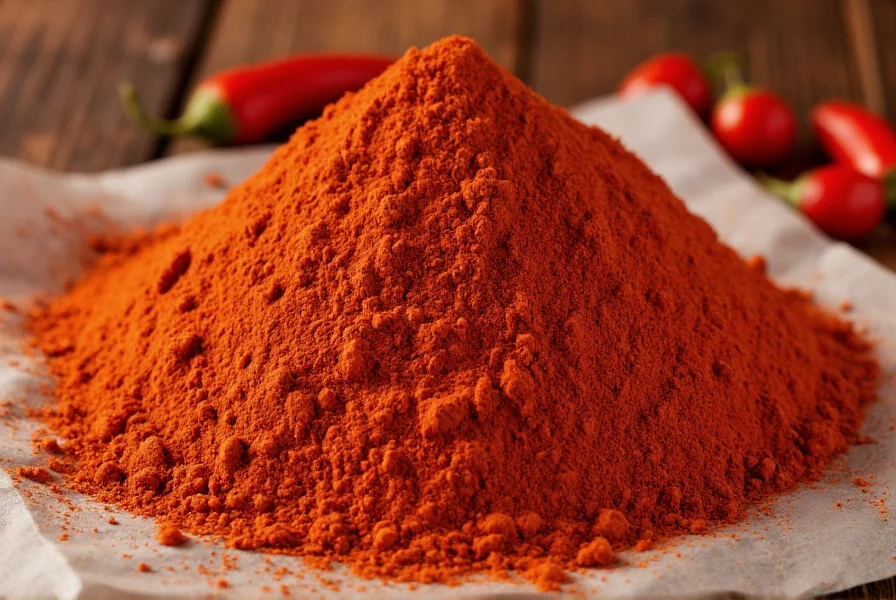Understanding powdered chili begins with recognizing it's not a single standardized product but rather a category with significant variation. The base ingredient consists of dried and ground chili peppers, but formulations differ dramatically based on regional preferences and intended culinary applications. While some blends focus on heat, others emphasize complex flavor notes with moderate spiciness.
Types of Powdered Chili and Their Characteristics
Not all chili powders are created equal. The market offers several distinct varieties, each serving different culinary purposes:
| Type | Heat Level (Scoville) | Primary Ingredients | Best Culinary Uses |
|---|---|---|---|
| Standard Chili Powder | 500-1,500 | Ancho, cumin, garlic, oregano | Tacos, chili con carne, enchiladas |
| Cayenne Pepper | 30,000-50,000 | 100% ground cayenne peppers | Adding pure heat to dishes |
| Chipotle Powder | 2,500-8,000 | Smoked jalapeños | Barbecue rubs, smoked dishes |
| Ancho Powder | 1,000-2,000 | Dried poblano peppers | Mole sauces, complex stews |
The difference between chili powder and cayenne pepper represents one of the most common points of confusion. While cayenne is a single-ingredient powder made exclusively from ground cayenne peppers, standard chili powder contains multiple spices designed to create a balanced flavor profile. This distinction significantly impacts recipe outcomes—substituting one for the other can dramatically alter both flavor and heat levels.

Culinary Applications and Technique Tips
Professional chefs understand that powdered chili performs best when used with specific techniques. For optimal flavor development, toast the powder briefly in oil before adding liquids to your dish. This "blooming" process unlocks essential oils and creates more complex flavor compounds. When making chili con carne or mole sauces, adding powdered chili early in the cooking process allows flavors to meld, while finishing dishes with a small amount of fresh powder provides brighter top notes.
For those wondering how to store powdered chili to maintain freshness, proper storage is critical. Exposure to light, heat, and moisture rapidly degrades quality. Store in an airtight container in a cool, dark cupboard—never above the stove where heat fluctuates. Properly stored, quality chili powder maintains peak flavor for 6-12 months, though it remains safe to consume much longer (with diminishing flavor intensity).
Substitutions and Alternatives
When you need a substitute for powdered chili in recipes, understanding flavor components helps create effective alternatives. A basic substitution combines 2 parts paprika, 1 part cumin, and a pinch of garlic powder. For recipes specifically requiring chipotle powder's smoky profile, add a few drops of liquid smoke to regular chili powder.
Homemade chili powder offers superior flavor control compared to commercial blends. Create your own by toasting dried chilies (like ancho, guajillo, and pasilla) until fragrant but not burnt, then grinding them in a dedicated spice grinder. Add complementary spices in proportions that match your preferred heat level and flavor profile. This approach lets you craft the best powdered chili for Mexican recipes tailored to your specific taste preferences.

Common Misconceptions Clarified
Several myths persist about powdered chili that affect cooking results. Many believe "hotter" always means "better," but mild powdered chili varieties often provide more nuanced flavor complexity essential for authentic dishes. Another misconception suggests all chili powders contain significant amounts of salt—most quality blends are salt-free, allowing cooks to control sodium levels independently.
Understanding the difference between mild vs hot powdered chili varieties helps cooks select appropriate products. Heat level depends primarily on the types of chilies used in the blend, not the overall "chili powder" category. Ancho-based powders typically offer mild, fruity notes, while blends containing arbol or cayenne deliver significant heat.
Practical Recommendations
When selecting powdered chili, check the ingredient list—quality products list specific chili varieties rather than vague "spices." For most home cooking applications, a standard chili powder blend provides the most versatile option. Specialty powders like ancho or chipotle work best when a recipe specifically calls for them or when you're targeting particular flavor profiles.
Remember that freshness dramatically impacts results. Purchase smaller quantities from stores with high turnover, and consider buying whole dried chilies to grind yourself when preparing dishes where chili flavor is central to the recipe. This approach ensures maximum flavor intensity and lets you create customized blends matching your preferred mild vs hot powdered chili balance.
What's the difference between chili powder and chili seasoning?
Chili powder refers to the ground dried chili peppers themselves, while chili seasoning contains additional ingredients like salt, garlic, and cumin. Most products labeled "chili powder" in supermarkets are actually chili seasoning blends. Pure chili powder contains only ground chilies.
Can I substitute paprika for chili powder?
Yes, but with adjustments. Use 2 tablespoons paprika plus 1 teaspoon cumin and 1/2 teaspoon garlic powder to replace 2 tablespoons chili powder. Note that smoked paprika creates a different flavor profile similar to chipotle powder rather than standard chili powder.
How can I reduce the heat of a dish that's too spicy from chili powder?
Add dairy products like yogurt or sour cream, which contain casein that binds to capsaicin. Acidic ingredients like lime juice can also help balance heat. For future reference, start with half the recommended amount of chili powder and adjust gradually during cooking.
Does powdered chili lose potency over time?
Yes, chili powder gradually loses both flavor and heat intensity. Properly stored in an airtight container away from light and heat, it maintains good quality for 6-12 months. After this period, it remains safe to eat but provides diminished flavor impact, requiring larger quantities to achieve the same taste effect.











 浙公网安备
33010002000092号
浙公网安备
33010002000092号 浙B2-20120091-4
浙B2-20120091-4